Kentucky Pesticide Safety Education Program

Questions?
Contact
Dr. Ric Bessin
Dept. of Entomology
University of Kentucky
859-257-7450
rbessin@email.uky.edu
originally prepared by Jim Newman, Extension Forestry Specialist
updated by Jeff Stringer, Extension Forestry Specialist, and Lee Townsend, Extension Entomologist, University of Kentucky
Herbicide Application
Classification of Herbicides
Herbicides can be grouped by silvicultural use, application methods, selectivity, or how they work (mode of action).
| Silvicultural Objective | Herbicide Objective | Application Methods |
|---|---|---|
| Timber Stand Improvement | Improve growth of desirable trees and create growing space for tree reproduction | Frill girdle, tree injection, hatchet injection, basal application |
| Site Preparation | Control existing competing vegetation before planting or seeding or to increase browse value and to create openings for wildlife. | Foliar spray |
| Pre-commercial thinning | Control stand density by thinning dense thickets of conifers or hardwoods that have not reached merchantable size | Basal bark, tree injection, hatchet injection |
| Release of conifers | Low release or high release | Foliage spray, basal bark, frill girdle, stump treatment, tree injection |
| Release of planted trees that need special treatment | To control grasses weeds and other competing vegetation around newly planted Christmas tree or walnut seedlings | Direct spray |
[return]
Herbicide Application Methods
Herbicides are the most commonly used pesticides in forestry. Applications may include high volume or low volume foliar spray treatment, basal bark treatment, stump treatment, tree injection and soil treatment with pellets.
Foliar Application
Foliar application includes both high and low volume techniques. High volume spraying is normally done with truck mounted equipment that deliver 60 to 400 gallons of solution per acre at high pressure through a hand-directed nozzle. This type of foliar spraying is fast and, in some instances, can deliver herbicide through dense brush. However, the risk of drift and unwanted effects on non-target plants is high. This technique requires more planning and precautions than other ground application techniques.
Foliage sprays should be made when leaves are fully expanded and the main spring sap flow has slowed (July through fall color change). Minimize pesticide drift from the treated site.
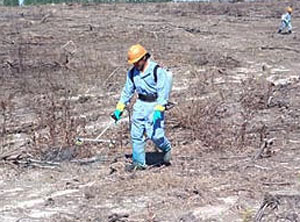
Weed control in newly planted plantation (superiorforestry.com)
Low volume spraying is normally done with hand-held equipment, such as backpack sprayers or low pressure ATV or tractor mounted sprayer, that deliver 10 to 60 gallons per acre at relatively low pressure through a hand-held wand. Low volume spraying also includes using boom sprayers and fixed height nozzles to apply herbicides to low growing grasses and weeds with a great deal of control over the amount and distribution of herbicide. It is often used for band or strip spraying. All types of low volume spraying are likely to cause fewer environmental problems compared to high volume techniques.
Both high volume and low volume hand-held wand techniques generally require that mixes contain a specific percentage of herbicide in the final water based solution. Labels also indicate that a specific amount of solution be applied per acre, ensuring that all foliage should be sprayed to a point of runoff.
Individual Stem Applications
Individual stem applications are used to apply herbicides directly onto or inside the stems of individual woody plants (trees or shrubs). Basal bark treatments are used to apply specific formulations of herbicides to the outer bark of the small woody plants. The herbicide is absorbed through the bark and eventually contacts the transport tissues and growing portions of the stem. A number of different methods including the use of tree injectors, frill and squirt techniques, Hypo-Hatchets® or similar devices, and cut stump treatments are used to deliver herbicides directly to the transport and growing tissues beneath the bark of woody plants.
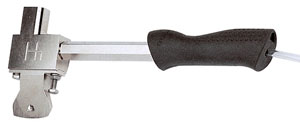
Hypo-hatchet (bladesandbushlore.com)
These treatments should not be applied to trees or shrubs where non-target plants of the same species or genera are nearby (generally within 10 to 20 feet). Trees and shrubs of the same species or genera may form root grafts, or may be sprouts from the same rootstock.
Basal bark treatments consist of several techniques to apply herbicides to the lower stem of small (less than 6 inches in diameter) trees and shrubs. Herbicides labeled for basal bark treatments are mixed with oil, instead of water. The full basal technique requires that the herbicide be thoroughly applied around the circumference of the lower 18 inches of tree. This is normally done using a backpack sprayer with a cone or flat fan tip. The streamline technique is used on trees or shrubs less than 3 inches in diameter and requires that a 6-inch wide band of herbicide be applied to one side of the stem. Enough of the solution should be applied to allow its spread around the entire circumference of the stem. The thinline technique is similar to streamlining, except that undiluted herbicide is used and only a thin band is sprayed completely around stem. The streamline and thinline techniques often are applied with a hand jet, which shoots a stream of solution, rather than a hand wand and nozzle used for the full basal technique.

Basal bark treatment (DowAgro.com)
Cut stump treatments are made on freshly cut stumps to prevent sprouting (coppicing) of hardwood trees and shrubs. Stumps should be treated with the undiluted herbicide within 1 to 2 hours after cutting. Once the cut surface dries, this treatment quickly loses its effectiveness. The entire surface area of stumps less than 10 inches in diameter should be covered. For larger stumps only the outer 3 to 4 inches should be treated. Backpack sprayers with hand wands, or handheld spray bottles, can be used to apply the herbicide.
Tree injection can be used to apply herbicide to the living tissues inside the bark of standing trees or shrubs. Tree injectors are specially designed 4- to 5-foot long tubes with an injection pump and 1.5 to 3 inch blade or injector on one end. They are used to apply either liquid or pellet herbicides to trees of any size. A liquid tree injector has a blade that produces a slit through the bark and then a pump delivers a calibrated amount of solution into the slit. Pellet injectors have a head on the tube which drives the pellet into the bark. The frill and squirt technique is also used to apply herbicides inside the stems of woody plants. This is done by using a hatchet to slit the bark and then using a hand sprayer to apply a calibrated amount of herbicide into the slit. Avoid application during heavy upward sap flow in the spring because sap flow out of the wound will prevent herbicide absorption.
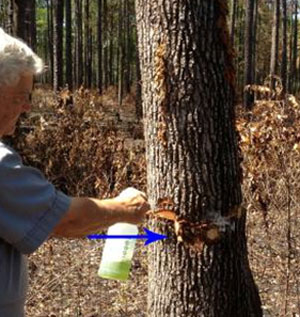
Hack and squirt herbicide application (forestry.about.com)
The Hypo-Hatchet® and Silvaxe® are examples of devices which combine the squirt mechanism directly into a specialty-designed hatchet. The liquid herbicide is placed in a container on a belt or backpack and is attached to the hatchet with a hose. The hatchet has a pump mechanism and injection ports built into the head. Striking the stem creates a slit and injects a calibrated amount of solution into the slit. Herbicides labeled for tree injection will indicate the amount of herbicide needed per inch of stem diameter and the spacing of injections around the stem.
Soil applied pellets can be used in very small amounts by hand broadcasting or specific placement around the stems of trees and shrubs (e.g., multiflora rose) or brush. After a rain, the solution is moved into the roots of woody plants which have their root systems within the dispersal area of the herbicide.
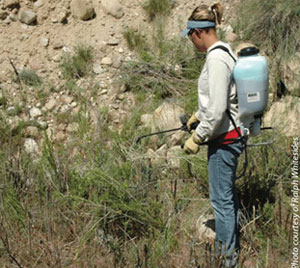
Spraying a post-emergence herbicide (photo: Ralph Whiteside)
Products applied to the foliage are commonly referred to as post-emergence herbicides. They control weeds either by direct contact with the plant tissue or by translocation to other plant parts. Weeds sprayed with contact herbicides usually die within a few hours or days. There is very little, if any, residual control. Weeds treated with translocated herbicides generally require several days to die. These herbicides are often capable of controlling annuals, biennials and perennials. Glyphosate (Accord, Roundup) and 2,4-D (several trade names) are examples of translocated herbicides.
[return]
Herbicide Selectivity
Herbicides may be classified as selective or non-selective. Selective herbicides kill some kinds of plants but have little or no effect on others. The use of selective herbicides allows the removal of unwanted plants from desirable species. For example, 2,4-D is a selective herbicide which will remove broadleaf weeds but will not injure grasses. However, the selectivity of a herbicide depends on the rate that is used. At low rates, some herbicides are selective but at high rates they become non-selective. Non-selective herbicides kill all vegetation. An example is glyphosate (Accord).
[return]
How Herbicides Work - Modes of Action
Herbicides with similar chemical characteristics are grouped into families. Here are examples of some of the common herbicides used in silviculture. They are listed by common name with some example brand names in parentheses and some information on how they affect plants.
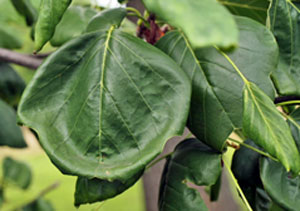
2,4-D damage to tulip poplar (lawn-care-academy.com)
2,4-D is a selective herbicide used to control annual and perennial broadleaf weeds. It is absorbed through the foliage and is translocated within the plant where it mimics natural plant hormones. Applications are made after weed emergence. Plants are most susceptible to damage when they are young and growing rapidly. Actively growing conifers are very susceptible to 2,4-D. Glyphosate (Accord) is a non-selective translocated herbicide. It acts by inhibiting amino acid production and protein synthesis.
Glyphosate is absorbed through the foliage and is translocated to the roots. It apparently has no soil activity. Accord can be used for site preparation, release, thinning, and removal of invasive plants.
Hexazinone (Velpar, Pronone) is a contact herbicide in liquid formulation that is applied to foliage (Velpar) or a granular (Pronone) formulation applied to the soil. It controls broadleaf and woody species and grasses and is used for selective weed control in conifers and for conifer release. Hexazinone can be applied when target plants are actively growing. Dormant season applications of Pronone granules over sensitive conifers will provide residual, soil active control for the next 1 or 2 growing seasons.
Imazapyr (Arsenal, Chopper, Contain) is a nonselective broad spectrum systemic herbicide with residual soil activity. It inhibits enzymes used to make some amino acids. Imazapyr is readily absorbed through foliage or roots. It is used to control most annual and perennial grasses, broadleaf weeds and woody species. It can be applied pre- or postemergence for long term control total vegetation on non-crop lands.
Metsulfuron (Escort, Ally) is a selective postemergence herbicide used at low rates to control broadleaf weeds and brush on non-cropland areas. It works in a plant by interfering with an enzyme which quickly stops cell division in roots and shoots. It can be used for site preparation or conifer release.
Picloram (Tordon) is a Restricted Use herbicide. It is a highly translocated, selective herbicide for broadleaf weeds and woody plants. It is active through the foliage and roots and has a long persistence in the soil, requiring precautions to avoid damage to desirable plants.
Triclopyr (Garlon 3) is a systemic growth regulating herbicide used to control woody and broadleaf perennial weeds in forests and rights of way. It also mimics natural plant hormones.
[return]
Soil Factors That Influence Herbicides
Soil texture, organic matter, pH and moisture content are some of the major soil properties that influence the efficacy of a soil-applied herbicide.
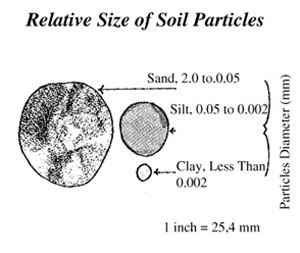
(blog.bolandbol.com)
Soil texture, the relative amounts of clay, silt, and sand in a soil, can determine the availability of certain herbicides. Usually, as the clay content of the soil increases, the amount of herbicide available for uptake in the plant decreases.
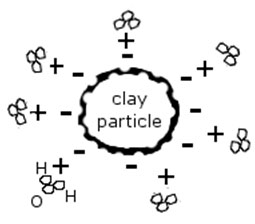
Clay particles tend to CLING to positively charged herbicides (blog.bolandbol.com)
Clay particles are primarily negatively (-) charged so they tend to attract or adsorb positively (+) charged particles. Herbicides which tend to be positively charged in the soil are bound to a greater extent by clay particles than herbicides which are negatively charged. This is why the rates of certain herbicides vary with soil texture.
Organic matter or humus content of the soil is primarily negatively (-) charged so herbicides can bind to it. In general, herbicides are more strongly adsorbed to humus than to clay particles. A small increase in the organic matter content of the soil can greatly reduce the effectiveness of some herbicides.
Soil pH can influence the effectiveness and persistence of certain herbicides. For example, metsulfuron (Escort) degrades rapidly when soil pH is less than 6.0. When soil pH is above 6.0, degradation rates are slower and depend more on soil microbes.
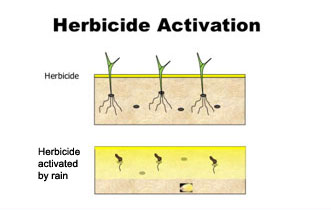
A certain amount of water is needed to activate a soil-applied herbicide (slideshare.net)
Herbicides applied to the soil surface must be moved into the root zone of the plants to be controlled soon after the application is made. Generally, soil-applied herbicides do not work as well under very dry conditions as they do when the soil moisture is adequate. Soil moisture also may indirectly affect the persistence of various herbicides by influencing their breakdown by microbes or certain chemical reactions. Soil-applied herbicides usually last longer when the soil is dry rather than when it is moist or wet.
[return]
Environmental Factors That Influence Herbicides
Results achieved from herbicide applications may vary greatly from one year to the next. This variability (often a lack of control) may be due to improper application (e.g., improper choice of herbicide, poor equipment, incorrect calibration, lack of agitation or ineffective product). Many of these problems can be prevented or corrected by the operator. However, much of the variability is due to factors which the applicator cannot control. These include environmental conditions, variation of soils and differences in susceptibility of various plant species.
Before considering the effect of environmental factors, it is essential to consider how the herbicide is applied. Herbicides may be applied as soil, foliage, stump or basal bark treatments. The influence of a given environmental factor may be quite different, depending on the type of application. Environmental conditions have very little effect on stump or basal bark treatments but they may have a great effect on soil and foliage applications.
Soil-Applied Herbicides
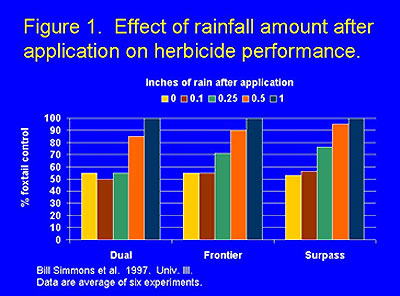
Effect of post-application rainfall amounts on control of a grass weed
(weeds.iastate.edu)
Rainfall (soil moisture) and temperature are two environmental factors that have the most influence on the performance of soil-applied herbicides. The amount of rainfall needed to move a herbicide depends on its water solubility. For example, a herbicide that is very soluble in water has a higher potential to move in soil with water compared to many other herbicides. Leaching of water-soluble herbicides is greatest under heavy rain that falls in a short period of time. Excessive movement of herbicide in the soil may cause injury to desirable plants close to areas that have been treated.
Temperature influences the performance of soil-applied herbicides by affecting chemical reactions in the soil, microbial activity and plant growth processes. Decomposition of herbicides by chemical reaction and microbial activity in the soil occurs more rapidly at high temperatures; therefore, herbicides are less persistent under these conditions. Temperature also has a profound effect on the absorption, translocation and metabolism of soil-applied herbicides by plants. Other factors being constant, the effects of these processes increase with increasing temperatures. Herbicides usually perform best under temperatures at which plants grow rapidly. Under conditions of extremely high or low temperatures, the toxicity and selectivity may be altered dramatically due to the influence of temperature on these physiological processes.
Herbicides Applied to Foliage

High humidity increases absorption of foliar-applied herbicide (pest.ca.uky.edu)
Humidity
Herbicides applied to foliage usually perform best when relative humidity is high. This greatly increases foliage absorption by delaying drying of spray droplets and by making the leaf cuticle more permeable. High relative humidity also may enhance translocation of systemic herbicides. Very light rainfall, such as a drizzle, dew or fog, increases absorption and effectiveness by remoistening the dry herbicide on the leaf surface. However, heavy rainfall shortly after application may wash the herbicide off the plant. The amount of the herbicide washed from the plant will depend on the quantity of precipitation, the rate of herbicide application, the chemical characteristics of the herbicide and the use of an additive. Water-soluble herbicides such as salt formulations of 2,4-D are washed off more easily than oil-soluble herbicides such as ester formulations of 2,4-D.
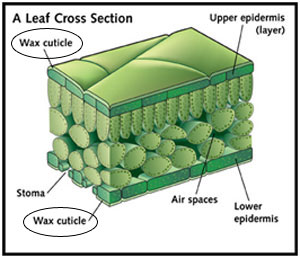
The cuticle is a waxy water-repellent layer that covers
all aboveground areas of a plant. (study.com)
Temperature
In addition to the effect of temperature on the plant's physiological processes, temperature also influences absorption of herbicides into leaves. Plants grown under high temperature frequently develop a thicker cuticle which restricts herbicide absorption. Due to the interaction of these physiological processes, the effect of the temperature at the time of application on herbicide performance depends on the herbicide being applied. In general, best results can be expected from foliar herbicides applied during warm weather to actively growing plants and followed by a period of several hours with no rainfall.
Sunlight
Sunlight is an additional environmental factor that influences the performance of many soil and foliar herbicides. It is essential for the activity of certain herbicides but it is seldom a limiting factor in their performance. However, the herbicide paraquat kills plants more rapidly on clear, sunny days and more slowly on cloudy days.
Drift
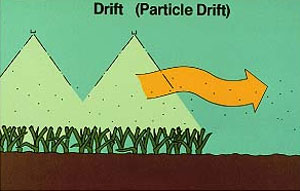
Off target movement of pesticide spray particles (personal.psu.edu)
Drift is the movement of spray particles or vapors through the air to areas not intended for treatment. The amount of drift depends on the particle or droplet size and the amount of air movement at the time of spraying. Herbicide spraying should not be done if the wind speed is greater than 5 miles per hour. Spray particles the size of fog or mist size present the greatest possibility for drift. These size particles are generated readily by high pressure spraying equipment and certain types of nozzles.
Volatilization
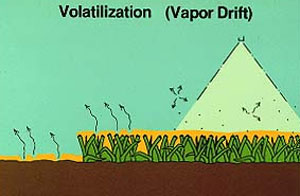
Off-target movement of pesticide vapors (personal.psu.edu)
Volatilization of herbicides is a chemical process whereby the herbicides change from a liquid to a gas. The herbicide, in the form of a gas or vapor, can move with the air currents for a mile or more to injure sensitive crops. Drift and volatilization represent potential hazards to sensitive crops, gardens and ornamentals, and may have harmful effects on wildlife, people, livestock and aquatic areas near application sites. In many cases, movement of herbicides off target results in complaints from the public or property owners. Complaints arising from herbicide application should be answered quickly and settled fairly.
[return]
Definitions
- Basal bark treatment - An application to the woody stems of plants at and just above the ground line and including the root crown.
- Frill and squirt-An individual tree application method where a hatchet or chainsaw is used to make a cut through the bark where the chemical is applied.
- Hypo-Hatchet® - An instrument used to inject a pre-measured amount of herbicide directly into the growing woody stem. Same as Silvax®.
- Soil sterilant-A chemical that prevents the growth of any organism in the soil-plants, animals or microorganisms; the effect may be temporary or long-lasting, depending on the chemical.
- Tree Growth Regulator (TGR)-A chemical which in small amounts alters the growth habits of trees.
- Tree injection-An application tool for injecting a herbicide directly through the bark of woody plants.
- Woody plants-Plants that live longer than two years and have a thick, tough stem or trunk covered with cork.
[return]
Environmental Concerns
Groundwater Advisories
The potential for contamination of groundwater must be considered when choosing pesticides. Several products have groundwater advisory statements on their label. Such statements advise not to apply these products where the water table (groundwater) is close to the surface and where the soils are very permeable (well-drained soils such as loamy sands). Refer to these statements and observe all precautions on the label when using these products.
Endangered Species
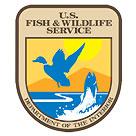
The Fish and Wildlife Service administers
the Endangered Species Act
[return]
References
Brooks, R. Forest Herbicides and their mode of action. U of Idaho CES Tree Planting and Care No. 15. Forest pest control. U Ga Special Bulletin 16 http://www.bugwood.org/pestcontrol/ Invasive plants of the eastern United States: Identification and Control. http://www.invasive.org/eastern Kentucky Woodlands Magazine Vol 1. SAF.
Herbicide use in forest management - a position of the Society of American Foresters. This publication, originally prepared by Jim Newman, Extension Forestry Specialist, is provided by the Pesticide Safety Education Program of the UK College of Agriculture. This version has been updated by Jeff Stringer, Extension Forestry Specialist, and Lee Townsend, Extension Entomologist.
http://www.ext.colostate.edu/mg/Gardennotes/331.pdf
1) ___________ is a fast means of applying foliar herbicides through dense brush but has a high potential for drift and environmental problems.
2) Stem applications of systemic herbicides not be applied to trees or shrubs where non-target plants of the same species or genera are within _________.
3) A systemic herbicide can be translocated from one tree to another through a root graft, killing or injuring the non-target tree.
4) Basal bark treatments are designed to apply herbicides to the lower stems of trees and shrubs less that _____ inches in diameter.
5) The full basal bark treatment technique requires that the herbicide be thoroughly applied around the circumference of the lower _____ inches of tree.
6) The streamline technique is designed to apply herbicides to the lower stems of trees and shrubs less that _____ inches in diameter.
7) Undiluted herbicide should be applied to cut stumps within _____ hour(s) after cutting.
8) Weeds sprayed with contact herbicides usually die within a few hours or days.
9) The use of _________ herbicides allows the removal of unwanted plants from desirable species.
10) Usually, as the clay content of the soil increases, amount of herbicide available for uptake in the plant ___________.
11)A small increase in the organic matter content of the soil can greatly increase the effectiveness of some herbicides.
12) Plants are least susceptible to herbicides when they are young and growing rapidly.
13) The herbicide active ingredient __________ is Restricted Use because it is highly translocated and very persistent in the soil.
14) _______ is the soil particle with the average smallest diameter.
15) Soil-applied herbicides work best when soil moisture is _____________.
16) Which of these factors that can reduce herbicide performance can be by the applicator?
17)The _________ of a herbicide affects the amount of rainfall needed to move it in the soil.
18) Plants are most susceptible to herbicides when they are growing under drought stress.
19) High relative humidity greatly ________ foliar absorption of herbicide spray droplets.
20) ______________ is seldom a factor that limits performance of most herbicides.
21) Herbicide spraying should be done only when ______________.
- there is no air movement
- Wind speed is not calm but less than 5 mph
- Wind speed is greater than 5 mph
22) Off-target movement of a pesticide can occur by drift or volitization.
23) ________ plants live longer than two years and have a thick, tough stem or trunk covered with cork.
24) __________ advise applicators not to apply certain pesticides where the water table is close to the surface and where the soils are very permeable.
- Endangered Species Acts
- Environmental Protection Warnings
- Product Safety Data Sheets
- Groundwater Advisories
photo credits: banner image-Jerry A. Payne, USDA Agricultural Research Service, Bugwood.org
website content by L. Townsend website design by P. Dillon copyright © 2016 University of Kentucky Department of Entomology
University of Kentucky College of Agriculture |
S-225 Agricultural Science Center North, Lexington, KY 40546-0091 | 859.257.7450
An Equal Opportunity University |
Last modified
11/30/2018
